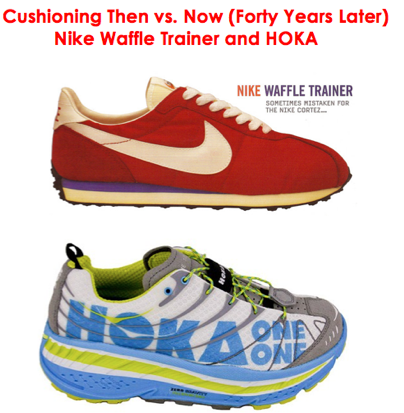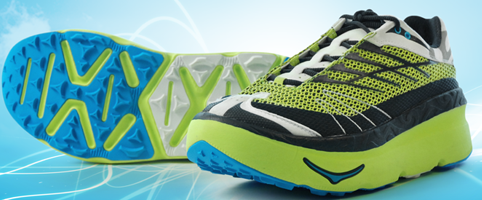By rudely pushing aside lean-’n-mean minimalist shoes in running stores, those beefy bullies known as maximalist shoes might one day be remembered as a shoe-category killer. We hope not. But consider all these brands boasting super-thick foam styles: Hoka One One, Brooks, Skechers, Puma, Vasque, New Balance and Altra.
Other shoes like Pearl Izumi’s Road M2, Scott’s eRide AeroFoam Trainer 2 and Nike’s Lunar Eclipse 4 come perilously close to extra-cushioning. In a noble attempt to shed light on the topic, Competitor magazine’s editor Brian Meltzer has written an informative article outlining the key attributes and questions surrounding what some are calling Hokamania.
Is maximalism yet another here-today-gone-tomorrow trendy fad? A shoe used mainly by ultrarunners who appreciate the extra midsole cushion for pushing out those extra miles? Or one celebrated by formerly injured runners who don’t mind wearing air bags on their feet?
 A particularly relevant question that Meltzer poses is this: “Don’t maximalist shoes lessen the proprioceptive interaction between your foot and the ground?” His answer is: “Yes, maximalist shoes definitely take away the ‘feel’ for the ground. But some runners say that’s an OK trade-off for having so much cushion.”
A particularly relevant question that Meltzer poses is this: “Don’t maximalist shoes lessen the proprioceptive interaction between your foot and the ground?” His answer is: “Yes, maximalist shoes definitely take away the ‘feel’ for the ground. But some runners say that’s an OK trade-off for having so much cushion.”
One thing that still remains to be investigated about maximalism is that as of yet, there have not been any independent scientific studies conducted on these plumpish running shoes. How, er, will they stack up against their skinny minimalist brethren?
It’s certainly fair not to tiptoe around a legitimate biomechanical concern and ask the following: Will this dependency on comfort today lead to long-term injury or future dysfunction such as muscular atrophy in areas of the foot and leg? In other words, are we born to run on shoes as thick as a short-stack of hotcakes?


just curious Bill why do you think maximalist shoes would “lead to long-term injury or future dysfunction such as muscular atrophy in areas of the foot and leg?”